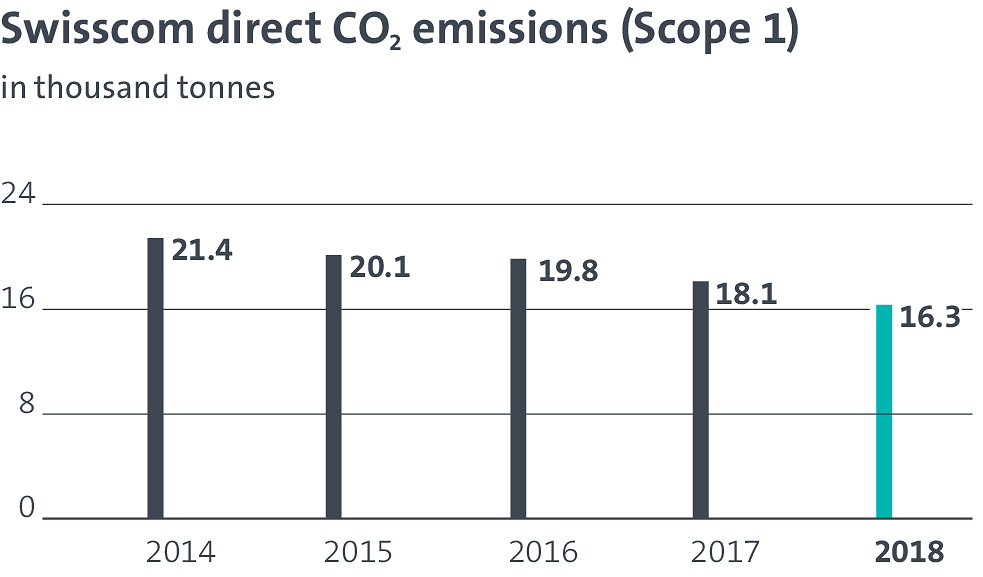Carbon footprint
Swisscom maintains a greenhouse gas inventory, publishes its emissions in a Climate Report according to recognised standards (ISO 14064) and has these verified externally. In accordance with the Greenhouse Gas Protocol (GHG), the company classifies its CO2 emissions as Scope 1 (direct emissions resulting from burning fossil fuels for heating and mobility or from refrigerants), Scope 2 (indirect emissions caused by purchased energies) and Scope 3 (all other indirect CO2 emissions, e.g. those in the supply chain).
- Scope 1 emissions: Direct consumption of fossil fuels accounted for 11% of Swisscom’s total direct energy consumption in 2018 (prior year: 13%). Scope 1 CO2-equivalent emissions from fossil fuels have fallen continually since 1 January 2010 and totalled 16,171 tonnes of CO2-equivalent in 2018, without adjustment for the number of heating days. Vehicle fuel accounted for 59% of this, and heating fuel for 41%. In addition, emissions from refrigerants included under Scope 1 were 118 tonnes (prior year: 352 tonnes). Swisscom does not include emissions from SF6 losses in electrical transformers and stations as it does not control these systems. The additional reduction in direct emissions (Scope 1) is due to building optimisations and the replacement of fossil fuels by heat pumps, biomass and the increased use of waste heat.

- Scope 2 emissions: Swisscom presents its Scope 2 emissions before and after offsetting. The CO2-equivalent emissions from electrical energy consumption before offsetting amounted to 58,168 tonnes of CO2-equivalent in 2018 (location-based approach) or 0 tonnes of CO2-equivalent after offsetting with market instruments (i.e. certificates; market-based approach). Under Scope 2, then, Swisscom did not emit any CO2 as a result of electricity consumption in 2018, but had a share of 1,052 tonnes of CO2-equivalent from district heating. Emissions according to Scope 2 are attributable exclusively to district heating, for which a compensation plan is in development.
- Scope 3 emissions: Swisscom determined its greenhouse gas emissions in accordance with the categories of Scope 3. The following categories were excluded: processing of sold products (category 10), downstream-leased assets (category 13) and franchises (category 14). These categories are not relevant, as in 2018 Swisscom did not manufacture any products, did not operate any distribution centres (downstream leased assets) and did not operate any franchises. Swisscom’s Scope 3 CO2 emissions amounted to 425,093 tonnes (prior year: 386,265 tonnes). CO2 equivalent emissions in the supply chain for the categories purchased goods and services (category 1), capital goods (category 2) and transport and distribution to distribution centres (category 4) amounted to 333,300 tonnes in 2018. They accounted for the lion’s share of Scope 3 emissions. Indirect emissions under Scope 3 are more difficult to control. The rise in these emissions is due to the slight increase in the volume of equipment and facilities purchased. Conversely, it was determined that new suppliers or suppliers included in the estimates for the first time exhibit high CO2 intensity. Fastweb is classified under category 15 (4,943 tonnes of CO2, is not incorporated 2:1 in the target calculation).
The Climate Report not only provides information on CO2 emissions, but also on the effects of the reduction measures implemented within the company and the achievement of the target. It also calculates the CO2 emissions that can be avoided by corporate customers and residential customers if they use sustainable ICT services certified by external partner myclimate. Finally, the Climate Report includes a balance sheet of CO2 emissions and savings among customers.
Swisscom is also involved each year in the Carbon Disclosure Project (CDP). The information gathered through the CDP regarding emissions and Swisscom’s commitment to climate protection can be viewed on the CDP platform. Swisscom was again listed on the Supplier and Climate A List (A-) and in the Carbon Disclosure Leadership Index (CDLI) in 2018.
See www.cdp.net